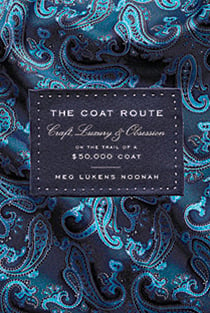Book review: The Coat Route
The Coat Route: Craft, Luxury & Obsession On The Trail Of A $50,000 Coat
Share

The Coat Route: Craft, Luxury & Obsession On The Trail Of A $50,000 Coat
By Meg Lukens Noonan
An Australian wine executive moves to Vancouver and needs clothing for the Canadian winter. Naturally, he commissions a $50,000 overcoat. Author Noonan read about the commission on the tailor’s website and thought the transaction obscene. What kind of vulgarian spends that much money on a coat? At the same time, curious about the bespoke tradition of custom-made clothing and the artisans of this age-old tradition, Noonan decided to trace the heritage of the coat’s rare vicuña wool and its creation. The result is a surprising perspective on the real value of a $50,000 coat.
The book’s introduction offers a sobering statistic: The U.S. throws away 13 million tonnes of textiles, mostly non-biodegradable, a year. How does that $200 coat from Zara sound now? The rest of the book offers a peek into an alternative way to dress: “slow” clothes made by craftsmen from sustainable materials with supply-chain traceability. Noonan visits the Peruvian Andes to witness the shearing of the vicuñas. She meets fourth-generation tailors on Savile Row and the Florentine silk printer who made the coat’s lining. She meets sixth-generation French fabric merchants, Yorkshire mill owners, British button-making dynasties and engraving artisans (there’s a shout-out to a Canadian goldsmith, Samuel Dibbs, who engraved 1,593 letters on a five-cent piece in 1899). In the atelier of John Cutler, the Sydney-based tailor who made the vicuña coat, she learns that his family’s 128-year-old business faces extinction as his artisans die out and he’s unable to find suitable apprentices.
But it’s not all bad news. Thanks to Downton Abbey, there is a surge of orders from Americans who want to dress like Lord Grantham. And the Vancouver wine executive, Keith Lambert, orders two more vicuña coats. Does he really need them? Probably not as much as Cutler needs the orders. Lambert, and Cutler’s other clients, we learn, are connoisseurs trying to preserve an artisan’s endangered way of life.